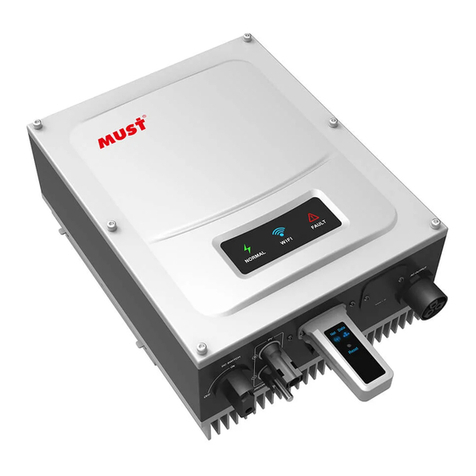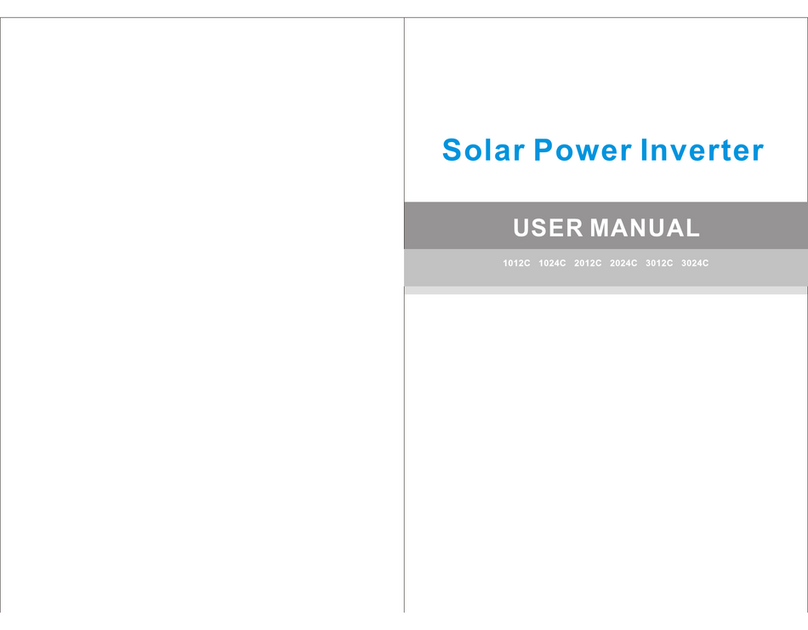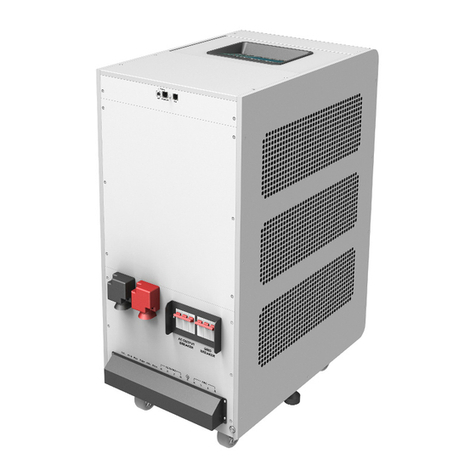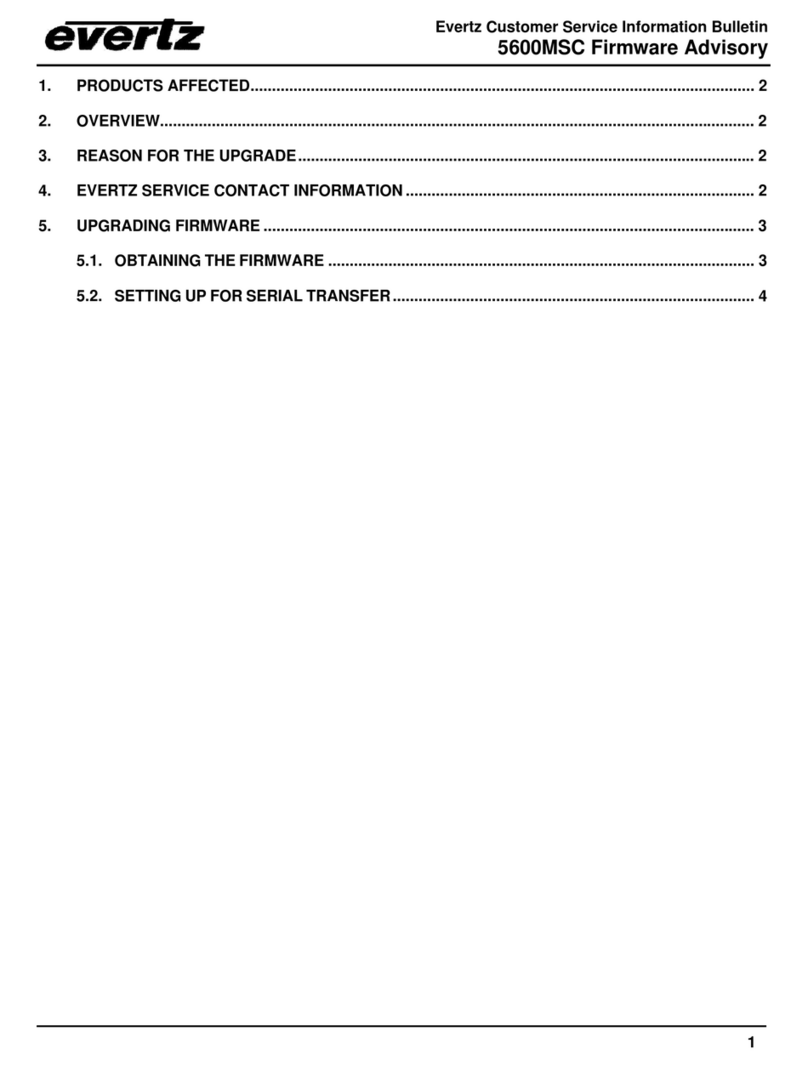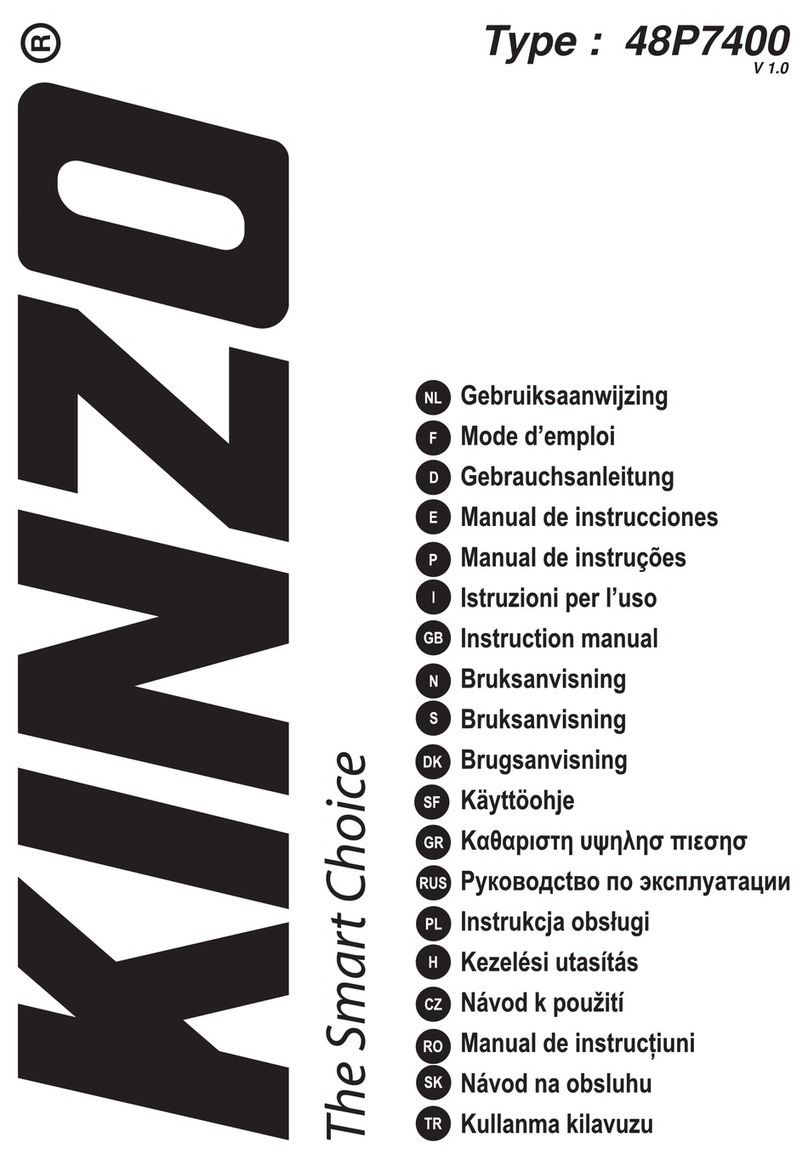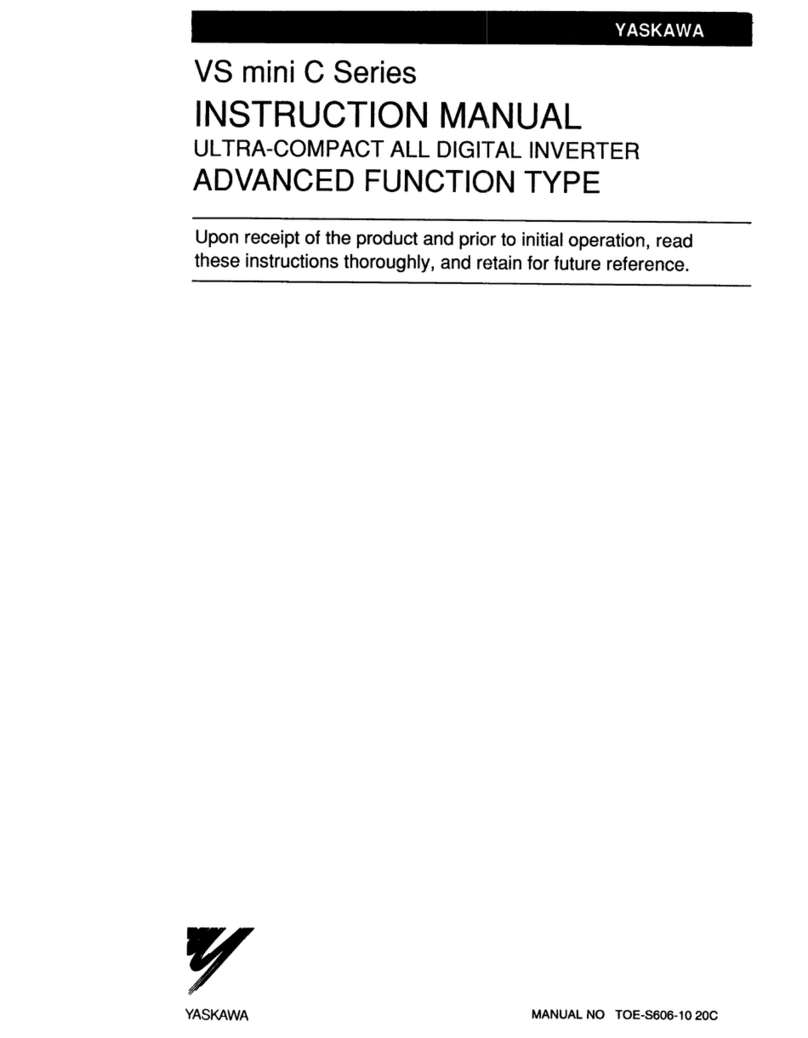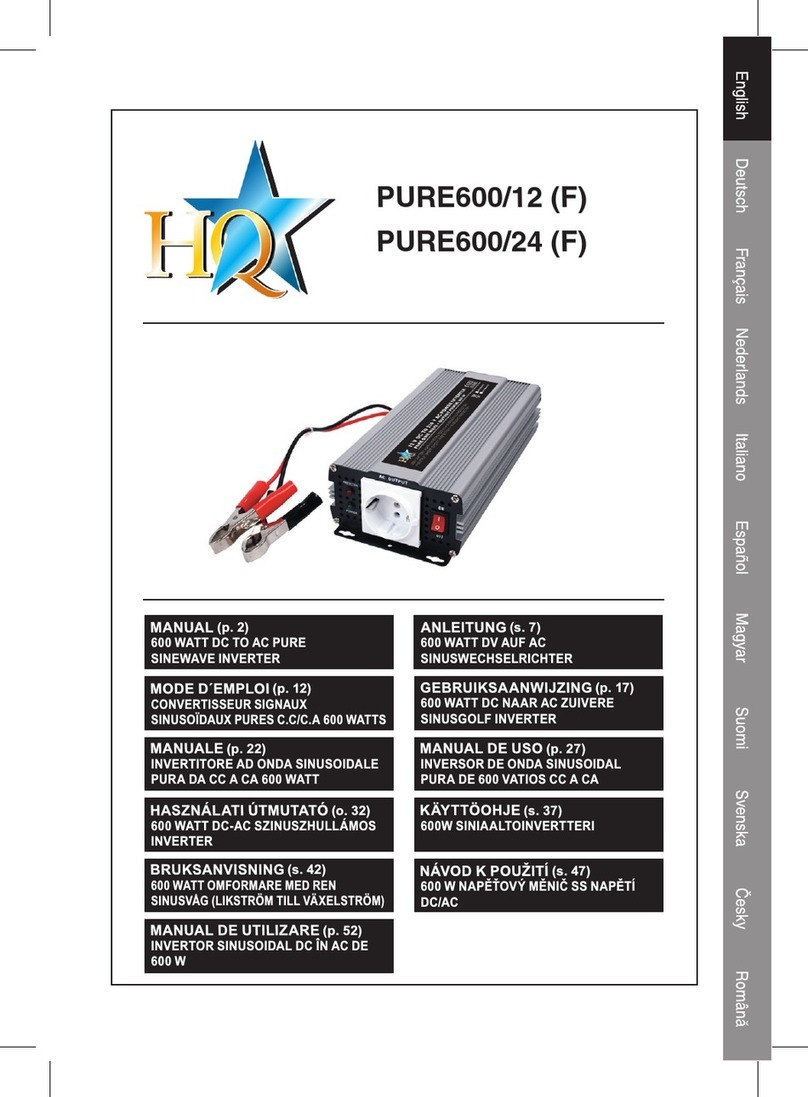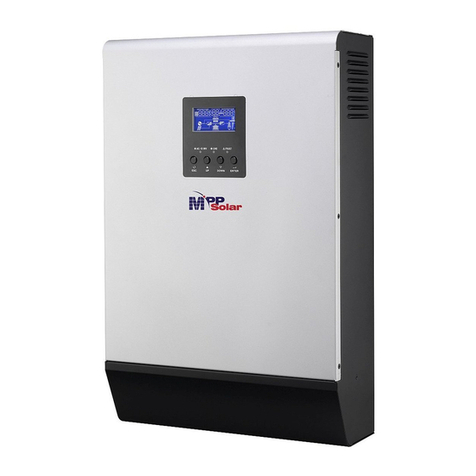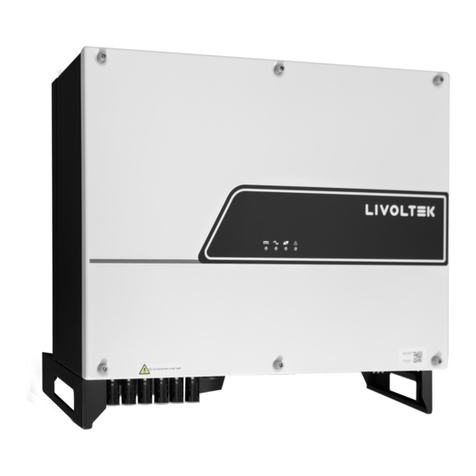Must EP18-5048 User manual

PC TV Air-
conditioning Fridge Washing
machine
Appliances
3KW- 5KW
INVERTER/CHARGER

Table of Contents
ABOUT THIS MANUAL ........................................................................................................1
Purpose ..........................................................................................................................1
Scope .............................................................................................................................1
SAFETY INSTRUCTIONS ....................................................................................................1
INTRODUCTION ...............................................................................................................2
Features ..........................................................................................................................2
Basic System Architecture ...................................................................................................2
Product Overview ..............................................................................................................3
INSTALLATION .................................................................................................................4
Unpacking and Inspection ...................................................................................................4
Preparation ......................................................................................................................4
Mounting the Unit ..............................................................................................................4
Battery Connection ............................................................................................................5
AC Input/ Output Connection ..............................................................................................6
Final Assembly .................................................................................................................8
Communication Connection ................................................................................................8
Dry Contact Signal ............................................................................................................8
OPERATION . ....................................................................................................................9
Power ON/OFF .................................................................................................................9
Operation and Display Panel ...............................................................................................9
LCD Display Icons ............................................................................................................10
LCD Setting ....................................................................................................................12
Fault Reference Code .......................................................................................................16
Warning Indicator ...........................................................................................................17
Operating Mode Description ..............................................................................................18
Display Setting ................................................................................................................18
SPECIFICATIONS . ..........................................................................................................19
Table 1 Line Mode Specifications .........................................................................................19
Table 2 Inverter Mode Specifications ....................................................................................20
Table 3 Charge Mode Specifications .....................................................................................21
Table 4 General Specifications ............................................................................................22
TROUBLE SHOOTING ...................................................................................................... 23
Appendix: Approximate Back-up Time Table .....................................................................24

ABOUT THIS MANUAL
Purpose
This manual describes the assembly, installation, operation and troubleshooting of this unit. Please read this manual
carefully before installations and operations. Keep this manual for future reference.
Scope
This manual provides safety and installation guidelines as well as information on tools and wiring.
The following cases are not within the scope of warranty
1. Out of warranty.
2. Series number was changed or lost.
3. Battery capacity was declined or external damaged.
4. Inverter was damaged caused of transport shift, remissness, ect external factor
5. Inverter was damaged caused of irresistible natural disasters.
6. Not in accordance with the electrical power supply conditions or operate environment caused damage.
SAFETY INSTRUCTIONS
WARNING: This chapter contains important safety and operating instructions. Read and keep
this manual for future reference.
1. Before using the unit, read all instructions and cautionary markings on the unit the batteries and all appropriate
sections of this manual.
2. CAUTION --To reduce risk of injury, charge only deep-cycle lead acid type rechargeable batteries. Other types
of batteries may burst, causing personal injury and damage.
3. Do not disassemble the unit. Take it to a qualified service center when service or repair is required. Incorrect
re-assembly may result in a risk of electric shock or fire.
4. To reduce risk of electric shock, disconnect all wirings before attempting any maintenance or cleaning. Turning
off the unit will not reduce this risk.
5. CAUTION --Only qualified personnel can install this device with battery.
6. NEVER charge a frozen battery.
7. For optimum operation of this inverter/charger, please follow required spec to select appropriate cable size. It' s
very important to correctly operate this inverter/charger.
8. Be very cautious when working with metal tools on or around batteries. A potential risk exists to drop a tool to
spark or short circuit batteries or other electrical parts and could cause an explosion.
9. Please strictly follow installation procedure when you want to disconnect AC or DC terminals. Please refer to
INSTALLATION section of this manual for the details.
10. Fuses (1 piece of 200A, 58VDC for 3KW,4KW and 5KW) are provided as over-current protection for the battery
supply.
11. GROUNDING INSTRUCTIONS- This inverter/charger should be connected to a permanent grounded wiring
system. Be sure to comply with local requirements and regulation to install this inverter.
12. NEVER cause AC output and DC input short circuited. Do NOT connect to the mains when DC input short circuits.
13. Warning!! Only qualified service persons are able to service this device. If errors still persist after following
troubleshooting table, please send this inverter/charger back to local dealer or service center for maintenance.
1

INTRODUCTION
This is a multi-function inverter/charger, combining functions of inverter, battery charger to offer uninterruptible
power support with portable size. Its comprehensive LCD display offers user-configurable and easy-accessible button
operation such as battery charging current, AC charger priority, and acceptable input voltage based on different
applications.
Features
Pure sine wave inverter
Configurable input voltage range for home appliances and personal computers via LCD setting
Configurable battery charging current based on applications via LCD setting
Configurable AC Charger priority via LCD setting
Compatible to mains voltage or generator power
Auto restart while AC is recovering
Overload/ Over temperature/ short circuit protection
Smart battery charger design for optimized battery performance
Cold start function
Basic System Architecture
The following illustration shows basic application for this inverter/charger. It also includes following devices to have a
complete running system:
Generator or Utility.
Consult with your system integrator for other possible system architectures depending on your requirements.
This inverter can power all kinds of appliances in home or office environment, including motor-type appliances such
as tube light, fan, refrigerator and air conditioner.
2

NOTE: For parallel model installation and operation,
please check separate parallel installation guide for
the details.
Product Overview
3
1. LCD display
2. Status indicator
3. Charging indicator
4. Fault indicator
5. Function buttons
6. Power on/off switch
7. AC input
8. AC output
9. Battery input
10. Circuit breaker
11. USB
12. RS485 communication port
13. Parallel communication port (only for parallel model)
14. Parallel switch
15. Dry contact
3KW-5KW single model
3KW-5KW parallel model

Mounting the Unit
Consider the following points before selecting where to install:
4
INSTALLATION
Unpacking and Inspection
Before installation, please inspect the unit. Be sure that nothing inside the package is damaged. You should have
received the following items inside of package:
The unit x 1
User manual x 1
USB cable x 1
Software CD x 1
Preparation
Before connecting all wirings, please take off bottom cover by removing two screws as shown below.
Do not mount the inverter on flammable construction materials.
Mount on a solid surface.
Install this inverter at eye level in order to allow the LCD display
to be read at all times.
For proper air circulation to dissipate heat, allow a clearance of
approx. 20 cm to the side and approx. 30 cm above and
below the unit.
o o
The ambient temperature should be between 0 c and 55 c to
ensure optimal operation.
The recommended installation position is to be adhered to the
wall vertically.
Be sure to keep other objects and surfaces as shown in the
diagram to guarantee sufficient heat dissipation and to have
enough space for removing wires
SUITABLE FOR MOUNTING ON CONCRETE OROTHER
NON-COMBUSTIBLE SURFACE ONLY.
At least
30cm
At least
20cm
At least
30cm

4KW
5KW
Model Typical Amperage Battery Capacity Wire Size
Ring Terminal
2
Cable mm
Torque Value
Dimensions
D(mm) L(mm)
84A
105A
200AH
200AH
1*4AWG
2*6AWG
1*4AWG
2*6AWG 2~ 3 Nm
2~ 3 Nm
22 6.4 33.2
14 6.4 29.2
22 6.4 33.2
14 6.4 29.2
5
3KW 63A 200AH 1*4AWG
2*6AWG 2~ 3 Nm
22 6.4 33.2
14 6.4 29.2
Please follow below steps to implement battery connection:
1. Assemble battery ring terminal based on recommended battery cable and terminal size.
2. Connect all battery packs as units requires. It's suggested to connect at least 200Ah capacity battery for 3KW~
5KW model.
Install the unit by screwing four screws
Battery Connection
CAUTION: For safety operation and regulation compliance, it's requested to install a separate DC over-current
protector or disconnect device between battery and inverter. It may not be requested to have a disconnect device in
some applications, however, it's still requested to have over-current protection installed. Please refer to typical
amperage in below table as required fuse or breaker size.
WARNING! All wiring must be performed by a qualified personnel.
WARNING! It's very important for system safety and efficient operation to use
appropriate cable for battery connection. To reduce risk of injury, please use the
proper recommended cable and terminal size as below.
Recommended battery cable and terminal size:
275.40mm
341.20mm
Inverter 3KW~5KW
12V 12V 12V 12V

3. Insert the ring terminal of battery cable flatly into battery connector of inverter and make sure the bolts are
tightened with torque of 2-3 Nm. Make sure polarity at both the battery and the inverter/charge is correctly
connected and ring terminals are tightly screwed to the battery terminals.
6
WARNING: Shock Hazard
Installation must be performed with care due to high battery voltage in series.
CAUTION!! Do not place anything between the flat part of the inverter terminal and the ring terminal.
Otherwise, overheating may occur.
CAUTION!! Do not apply anti-oxidant substance on the terminals before terminals are connected tightly.
CAUTION!!Before making the final DC connection or closing DC breaker/disconnector, be sure positive
(+) must be connected to positive (+) and negative (-) must be connected to negative (-).
AC Input/Output Connection
CAUTION!! Before connecting to AC input power source, please install a separate AC breaker between inverter and
AC input power source. This will ensure the inverter can be securely disconnected during maintenance and fully
protected from over current of AC input. The recommended spec of AC breaker is 32A for 3KW,40A for 4KW and 50A
for 5KW.
CAUTION!! There are two terminal blocks with "IN" and "OUT" markings. Please do NOT-misconnect input and
output connectors.
WARNING! All wiring must be performed by a qualified personnel.
WARNING! It's very important for system safety and efficient operation to use appropriate cable for AC input
connection. To reduce risk of injury, please use the proper recommended cable size as below.
Torque ValueModel Gauge
4KW
5KW
10 AWG
8 AWG
1.4~ 1.6Nm
1.4~ 1.6Nm
3KW 12 AWG 1.2~ 1.6Nm
Suggested cable requirement for AC wires
Please follow below steps to implement AC input/output connection:
1. Before making AC input/output connection, be sure to open DC protector or disconnector first.
2. Remove insulation sleeve 10mm for six conductors. And shorten phase L and neutral conductor N 3mm.
3. Insert AC input wires according to polarities indicated on terminal block and tighten the terminal screws. Be sure
to connect PE protective conductor ( ) first.

Ground (yellow-green)
L LINE (brown or black)
N Neutral (blue)
7
Ground (yellow-green)
L LINE (brown or black)
N Neutral (blue)
WARNING:
Be sure to that AC power source is disconnected before attempting to hardwire it to the unit.
4. Then, insert AC output wires according to polarities indicated on terminal block and tighten terminal screws.
Be sure to connect PE protective conductor ( )first.
5. Make sure the wires are securely connected.
CAUTION: Important
Be sure to connect AC wires with correct polarity. If L and N wires are connected reversely, it may cause utility
short-circuited when these inverters are worked in parallel operation.
CAUTION: Appliances such as air conditioner are required at least 2~3 minutes to restart because it's required to
have enough time to balance refrigerant gas inside of circuits. If a power shortage occurs and recovers in a short
time, it will cause damage to your connected appliances. To prevent this kind of damage, please check manufacturer
of air conditioner if it's equipped with time-delay function before installation. Otherwise, this inverter/charger will
trig overload fault and cut off output to protect your appliance but sometimes it still causes internal damage to the
air conditioner.
Final Assembly
After connecting all wirings, please put bottom cover back by screwing two screws as shown below.

8
A
Communication Connection
Please use supplied communication cable to connect to inverter and PC. Insert bundled CD into a computer and
follow on-screen instruction to install the monitoring software. For the detailed software operation, please check
user manual of software inside of CD.
WARNING:It’s forbidden to use network cable as the communication cable to directly communicate with the PC
port. Otherwise,the internal components of the controller will be damaged.
WARNING:RJ45 interface is only suitable for the use of the company’s supporting products or professional
operation.
Below chart shows RJ45 Pins definition
CANL
CANH
definition
Dry Contact Signal
There is one dry contact (3A/250VAC) available on the rear panel. It could be used to deliver signal to external device
when battery voltage reaches warning level.
NC C NO
Unit status Condition Dry contact port:
Power Off Unit is off and no output is powered.
NC&C NO&C
Close Open
Close Open
Open Close
Close Open
Open Close
Close Open
output is powered from Utility
Output is
powered
from Battery.
Program 01
set as utility
Power On
Battery voltage<Low DC warning
voltage
Battery voltage>Setting value in
Program 21 or battery charging
reaches floating stage
Battery voltage<Setting value in
Program 20
Battery voltage>Setting value in
Program 21 or battery charging
reaches floating stage
Program 01
is set as BAU
or BOU.

Messages
Yellow
Red
Solid On
Flashing
Flashing
Output is powered by grid in Line mode.
Output is powered by battery.
Battery is charging or discharging.
Fault occurs in the inverter.
Warning condition occurs in the inverter.
Solid On
Flashing
Function Keys
MENU
UP
DOWN
ENTER
Description.
Increase the setting data.
Decrease the setting data.
Enter setting mode and Confirm the selection in setting mode go to next selection or exit the
reset mode.
Enter reset mode or setting mode go to previous selection.
OPERATION
Power ON/OFF
Once the unit has been properly installed and the batteries are connected well, simply press On/Off switch (located
on the button of the case) to turn on the unit.
Operation and Display Panel
The operation and display panel, shown in below chart, is on the front panel of the inverter. It includes three indicators,
four function keys and a LCD display, indicating the operating status and input/output power information.
LED Indicator
LED Indicator
AC/INV Green
CHG
FAULT
Function Keys
9

Icon Function description
Input Source Information and Output Information
Iindicates the AC information
Indicates the DC information
Indicate input voltage, input frequency, battery voltage and charger current.
Indicate output voltage, output frequency, load in VA, load in Watt and discharging current.
Configuration Program and Fault Information
Indicates the setting programs
Iindicates the warning and fault codes.
Warning: flashing with warning code.
Fault: lighting with fault code.
Battery Information
Indicates battery level by 0-24%, 25-49%, 50-74% and 75-100% in battery mode and
charging status in line mode.
In AC mode, it will present battery charging status.
Status
Constant Current
mode/Constant
Voltage mode
Batteries are fully charged.
>2.167V/cell
2.083v/cell~2.167v/cell
2v/cell~2.083v/cell
<2V/cell
Battery voltage LCD Display
4 bars will flash in turns
Bottom bar will be on and the other three
bars will flash in turns.
Bottom three bars will be on and the top bar
will flash.
4 bars will be on.
Bottom two bars will be on and the other
two bars will flash in turns.
LCD Display Icons
10

In battery mode, it will present battery capacity.
Load Percentage Battery Voltage LCD Display
Load >50%
<1.717V/cell
1.717V/cell~1.8V/cell
1.8V/cell~1.883V/cell
>1.883 V/cell
<1.817V/cell
1.817V/cell~1.9V/cell
50%> Load>20%
1.9 V/cell ~1.983V/cell
>1.983 V/cell
Load<20%
<1.867V/cell
1.867V/cell~1.95V/cell
1.95V/cell~2.033V/cell
>2.033 V/cell
Load Information
Indicates overload.
Indicates the load level by 0-24%, 25-49%, 50-74% and 75-100%.
0%~24% 25%~49% 50%~74% 75%~100%
Mode Operation Information
Indicates unit connects to the mains.
Indicates load is supplied by utility power.
Indicates the DC/AC inverter circuit is working.
Mute Operation
Indicates unit alarm is disabled.
11

LCD Setting
After pressing and holding "ENTER" button for 2 seconds, the unit will enter setting mode. Press "UP" or "DOWN"
button to select setting programs. And then, press "ENTER" or "MENU" button to confirm the selection and exit.
Setting Programs:
Program Description Selectable option
00 Exit setting mode
Escape
Output source priority selection
01
Utility provides power to the loads only
when battery voltage drops to either
low-level warning voltage or the setting
point in program 20 or battery is not
sufficient. The battery energy will supply
power to the load in the condition of the
utility is unavailable or the battery
voltage is higher than the setting point
in program 21(when LU is selected) or
program 20(when LB is selected).
If battery voltage has been higher than
the setting point in program 21 for 5
minutes, the inverter will turn to battery
mode, battery will provide power to the
load.
When the battery voltage drops to the
settingpoint in program 20, the inverter
will turn tobypass mode, utility provides
power to the load .
(default) Utility will provide power to the loads as
first priority.
AC input voltage range
02
Appliances (default) If selected, acceptable AC input voltage
range will be within 90-280VAC.
UPS If selected, acceptable AC input voltage
range will be within 170-280VAC.
GEN When the user uses the device to
connect the generator, select the
generator mode.
VDE If selected, acceptable AC input voltage
range will conform to VDE4105
(184VAC-253VAC)
Output voltage
03 Set the output voltage amplitude,
(220VAC-240VAC)
12

04 Output frequency
Overload bypass: When enabled,
the unit will transfer to line mode
if overload occurs in battery mode.
06
Auto restart when overload
occurs
07
50HZ(default) 60HZ
(default)
Load supply priority
05
When the utility is available, if the
battery voltage is lower than the setting
point in program 21, the energy will
never supply to the load or feed into the
grid, only charge the battery. If the
battery voltage is higher than the setting
point in program 21, the energy will
supply to the load or feed into the grid
or re charge the battery.
If the battery voltage is lower than the
setting point in program 20, the energy
will never supply to the load or feed into
the grid, only charge the battery. If the
battery voltage is higher than the setting
point in program 20, the energy will
supply to the load or feed into the grid
or recharge the battery.
Bypass disable Bypass enable(default)
Restart disable(default) Restart enable
Restart disable(default) Restart enable
Auto restart when over
temperature occurs
08
Battery energy feed to grid
configuration
09
(default) Battery energy feed to grid disable.
Battery energy feed to grid enable. In
the BAU mode, if the battery voltage is
higher than the setting point in program
21 (when LU is selected) or program 20
(when LB is selected), the battery
energy will be allowed to feed into the
grid.
Charger source priority:
To configure charger source
priority
10
Enable utility charge
(default)
Disable utility charge
If this inverter/charger is working in Line, Standby or Fault mode,
charger source can be programmed as below:
13 Maximum utility charging current
30A (default) Setting range is from 1A to 60A.
Increment of each click is 1A.
13

AGM (default)
Battery type
14
Flooded
GEL LEAD
Lithium Ion User-Defined
If "User-Defined" LI is selected, battery charge voltage and low
DC cut-off voltage can be set up in program 17, 18 and 19.
Bulk charging voltage
(C.V voltage)
17 If "User-Defined" LI is selected in program 14, this program can
be set up. Setting range is from 48.0V to 58.4V for 48Vdc model.
Increment of each click is 0.1V.
48V model default setting: 56.4V
48V model default setting: 54.0V
Floating charging voltage
18 If "User-Defined" LI is selected in program 14, this program can
be set up, Setting range is from 48.0V to 58.4V for 48Vdc model.
Increment of each click is 0.1V.
Low DC cut off battery voltage
setting
19
48V model default setting: 40.8V
If "User-Defined" LI is selected in program 14, this program can
be set up. Setting range is from 40.8V to 48.0V for 48Vdc model.
Increment of each click is 0.1V. Low DC cut-off voltage will be
fixed to setting value no matter what percentage of load is
connected.
If selected, the display screen will stay
at latest screen user finally switches.
20 Battery stop discharging voltage
when grid is available
Available options for 48V models:
46.0V (default) Setting range is from 44.0V to 58.0V.
Increment of each click is 0.1V.
Battery stop charging voltage
when grid is available
21
Available options for 48V models:
Setting range is from 44.0V to 58.0V.
Increment of each click is 0. 1V.
54.0V (default)
Auto turn page
(default) If selected, the display screen will auto
turn the display page.
22
14

23 Backlight control
24 Alarm control
Alarm on (default)
Backlight on Backlight off (default)
Alarm off
25 Beeps while primary source is
interrupted
Alarm on Alarm off (default)
27 Record Fault code
Record enable(default) Record disable
30 Battery equalization
Battery equalization Battery equalization disable(default)
31 Battery equalization voltage Available options for 48V models:57.6V
Setting range is from 48.0V to 58.4V for 48V model.
Increment of each click is 0.1V.
33 Battery equalization time
60min(default) Setting range is from 5 min to 900min.
Increment of each clink is 5min.
120min(default) Setting range is from 5 min to 900min.
Increment of each clink is 5min.
30days(default) Setting range is from 0 to 90days.
Increment of each clink is 1 day.
34 Battery equalization timeout
35 Equalization interval
29 Power saving mode enable/
disable
Saving mode disable
(default)
If disable, no matter connected load is
low or high, the on/off status of inverter
output will not be effected.
Saving mode enable If enable, the output of inverter will
be off when connected load is pretty
low or not detected.
15
36 Equalization activated
immediately
Enable Disable(default)
If equalization function is enabled in program 30, this program
can be set up. If “Enable”is selected in this program, it’s to
activate battery equalization immediately and LCD main page
will shows“ ”. If “Disable”is selected, it will cancel equalization
function until next activated equalization time arrives based on
program 35 setting. At this time, “ ” will be shown in LCD
main page too.

After pressing and holding “MENU” button for 6 seconds, the unit will enter reset model. Press “UP” and “DOWN”
button to select programs. And then, press “ENTER” button to exit.
Reset setting disable
Reset setting enable
(default)
16
37 BMS control method
Voltage method(default) SOC Percent method
20﹪(default) Setting range is from 20﹪ to 100﹪
Increment of each click is 1﹪.
95﹪(default) Setting range is from 20﹪ to 100﹪
Increment of each click is 1﹪.
38
Battery stop discharging
percent When SOC is
available
39
Battery stop charging
percent When SOC is
available
﹪
﹪
Fault Reference Code
Fault Code Fault Cause LCD Indication
01
02
03
04
Fan is locked when inverter is off
Inverter transformer over temperature
Battery voltage is too high
Battery voltage is too low
05
06
07
08
09
Output short circuited
Overload time out
Inverter bus voltage is too high
Bus soft start failed
11
21
22
Main relay failed
Inverter output voltage sensor error
Inverter grid voltage sensor error
23 Inverter output current sensor error
25 Inverter load current sensor error
24 Inverter grid current sensor error

17
26
27
Inverter grid over current error
Inverter radiator over temperature
41
42
43
Inverter grid voltage is low
Inverter grid voltage is high
Inverter grid under frequency
Inverter grid over frequency
44
56 Battery connection is open
51
52
53
55
Inverter over current protection error
Inverter bus voltage is too low
Inverter soft start failed
Over DC voltage in AC output
57 Inverter control current sensor error
58 Inverter output voltage is too low
61
62
63
64
Warning Code Warning Event Icon flashing
Fan is locked when inverter is on.
Fan 2 is locked when inverter is on.
Battery is over-charged.
Low battery
67
70
77
Overload
Output power derating
Parameter error
Warning Indicator

Off-Grid state The inverter will provide output power
from battery.
Stop mode The inverter stop working if you turn off
the inverter by the soft key or error has
occurred in the condition of no grid.
Operating State Description
Operating State Description LCD display
Charge state grid charge batteries.
Bypass state Error are caused by inside circuit error or
external reasons such as over temperature,
output short circuited and so on.
Match load state
Note: DC power produced from your solar
array is converted by the inverter into AC
power, which is then sent to your main
electrical panel to be used by your
household appliances. Any excess power
generated is not sold back to the grid, but
stored in battery.
Sell state
Note:
*Sell mode: The system generates
electricity form the batteries, supplying
power to your home and sending any
excess power back to the grid.
Battery energy is sold back to grid.
Converter by the inverter to the AC load.
18
Display Setting
The LCD display information will be switched in turns by pressing "UP" or "DOWN" key. The selectable information is
switched as below order: battery voltage, battery current, inverter voltage, inverter current, grid voltage, grid
current, load in Watt, load in VA, grid frequency, inverter frequency.
Battery voltage/DC discharging current
Inverter output voltage/Inverter output current
Grid voltage/Grid current
Load in Watt
Grid frequency/Inverter frequency
Selectable information LCD display
Table of contents
Other Must Inverter manuals
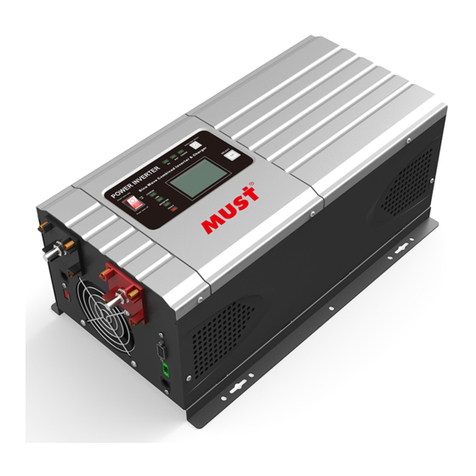
Must
Must PV3000 PK User manual
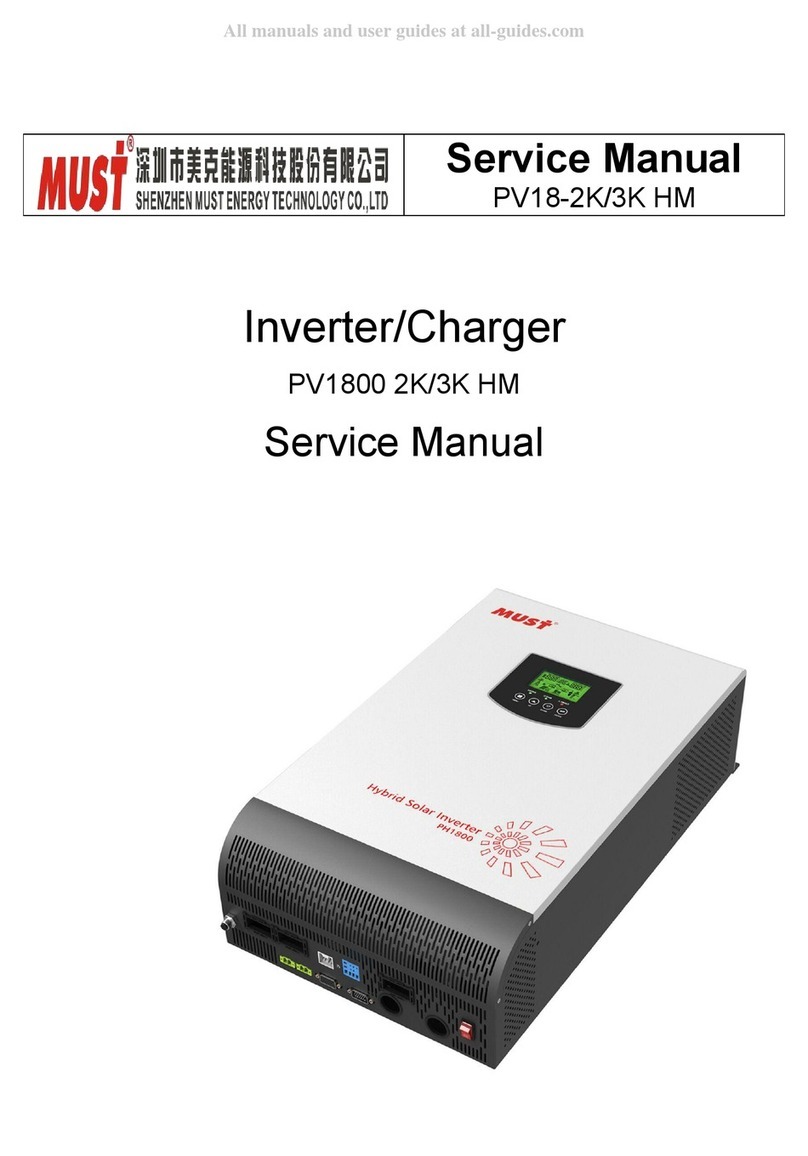
Must
Must PV1800 2K HM User manual
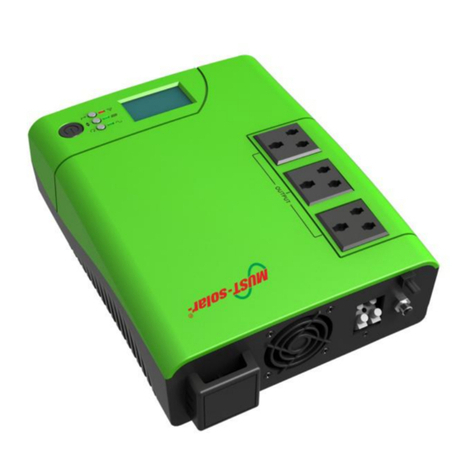
Must
Must PV1100 PLUS Series User manual
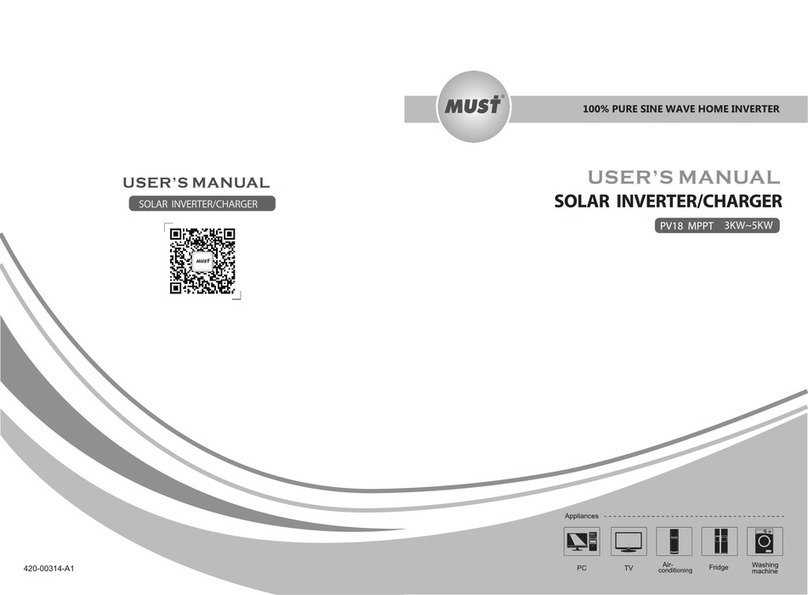
Must
Must PV18 MPPT 3 KW User manual
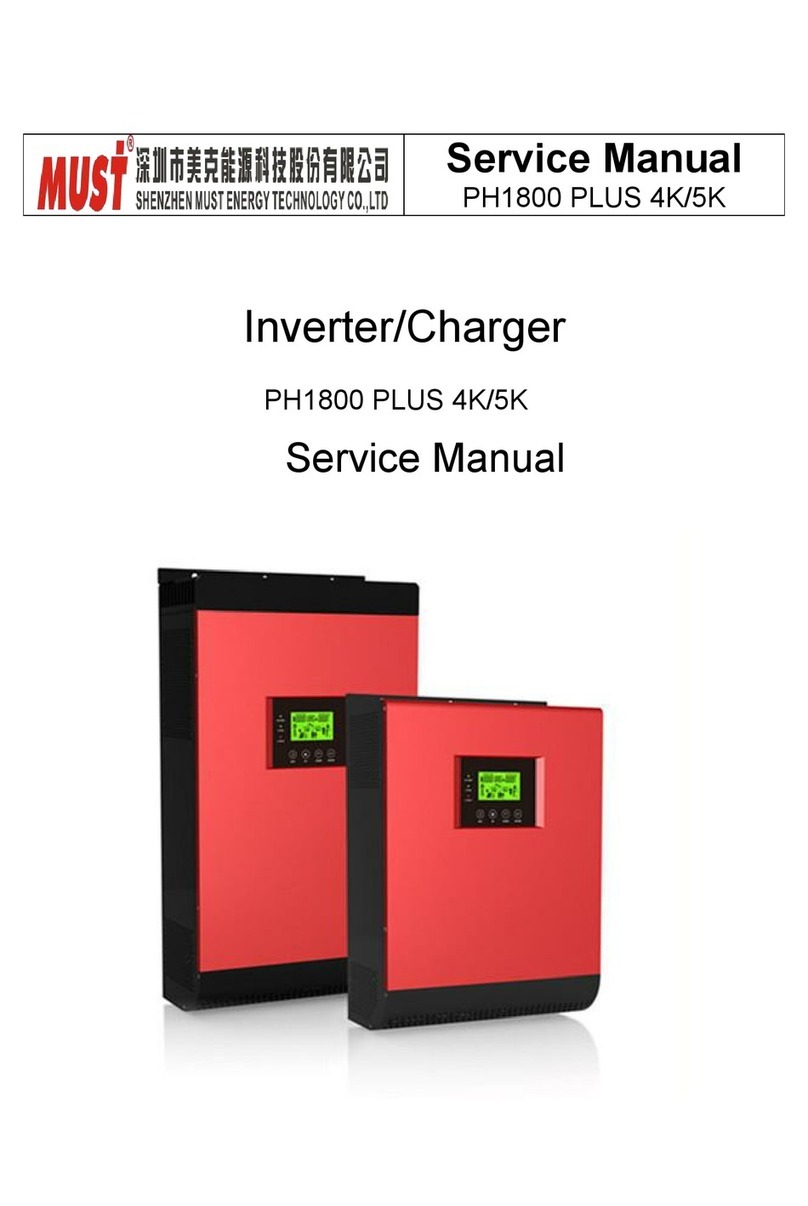
Must
Must PH1800 PLUS 4K User manual
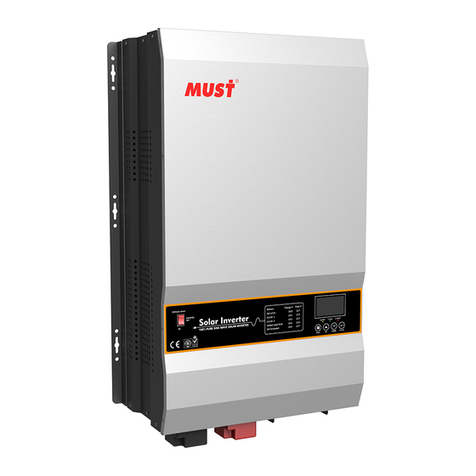
Must
Must pv3500 User manual

Must
Must pv3500 User manual
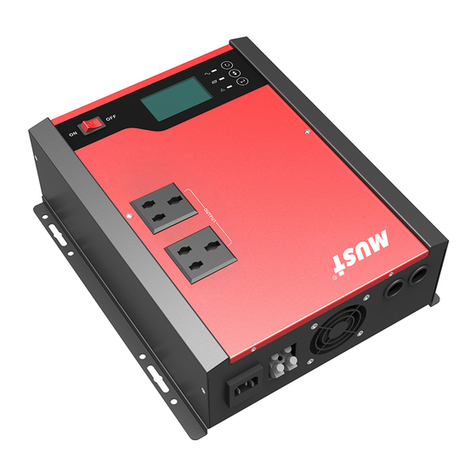
Must
Must PV1100 PLUS 1200VA User manual
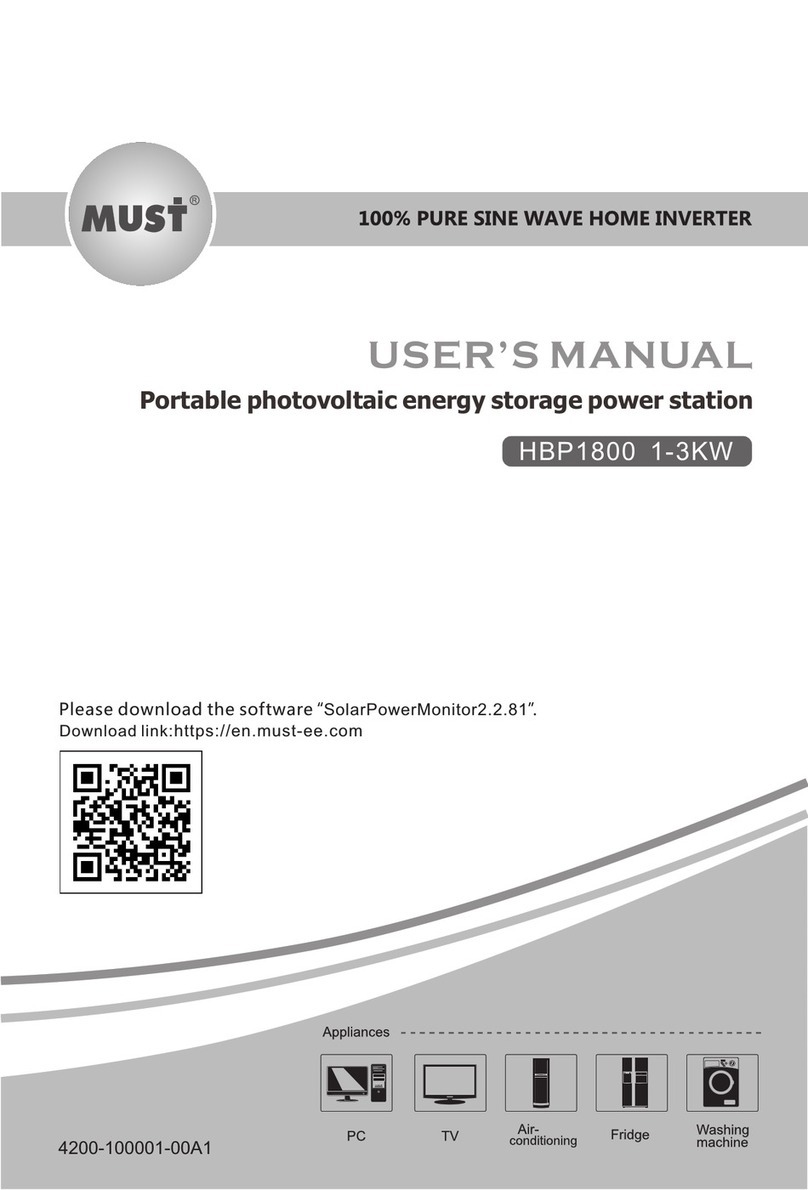
Must
Must HBP1800 User manual

Must
Must EP33-1024TLV User manual
Popular Inverter manuals by other brands

Fullwat
Fullwat PDA300S user manual
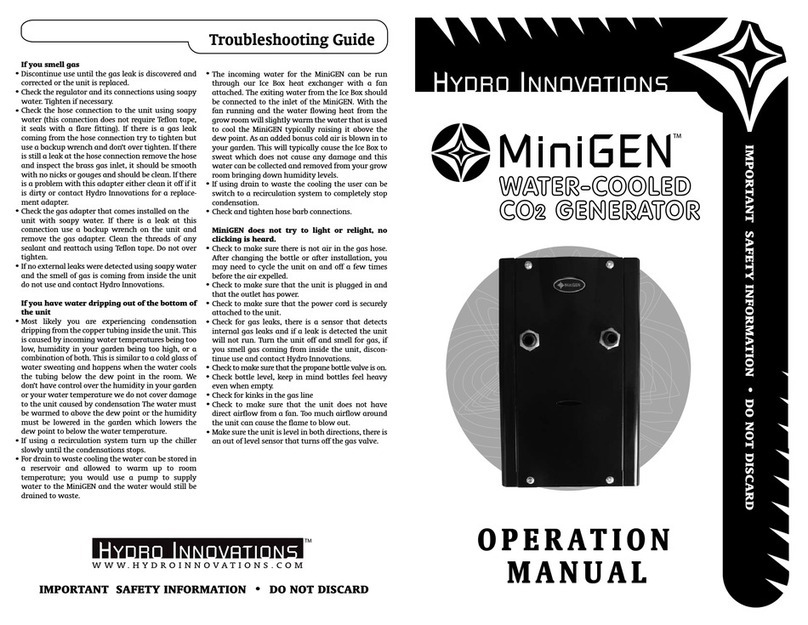
hydro innovations
hydro innovations MiniGEN Operation manual

Mitsubishi Electric
Mitsubishi Electric FR-E5NP instruction manual

Generac Power Systems
Generac Power Systems 005914-0 overview

TOYODenki
TOYODenki ed64sp instruction manual
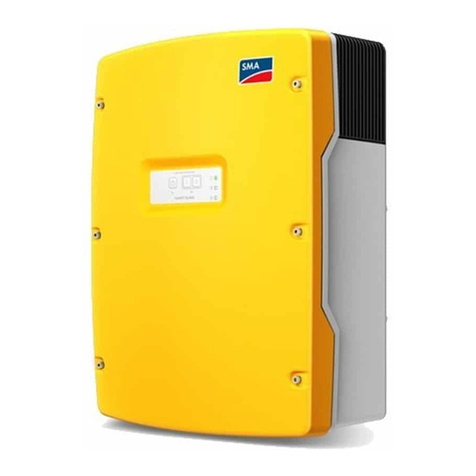
SMA
SMA SUNNY ISLAND 4.4M Quick reference guide
